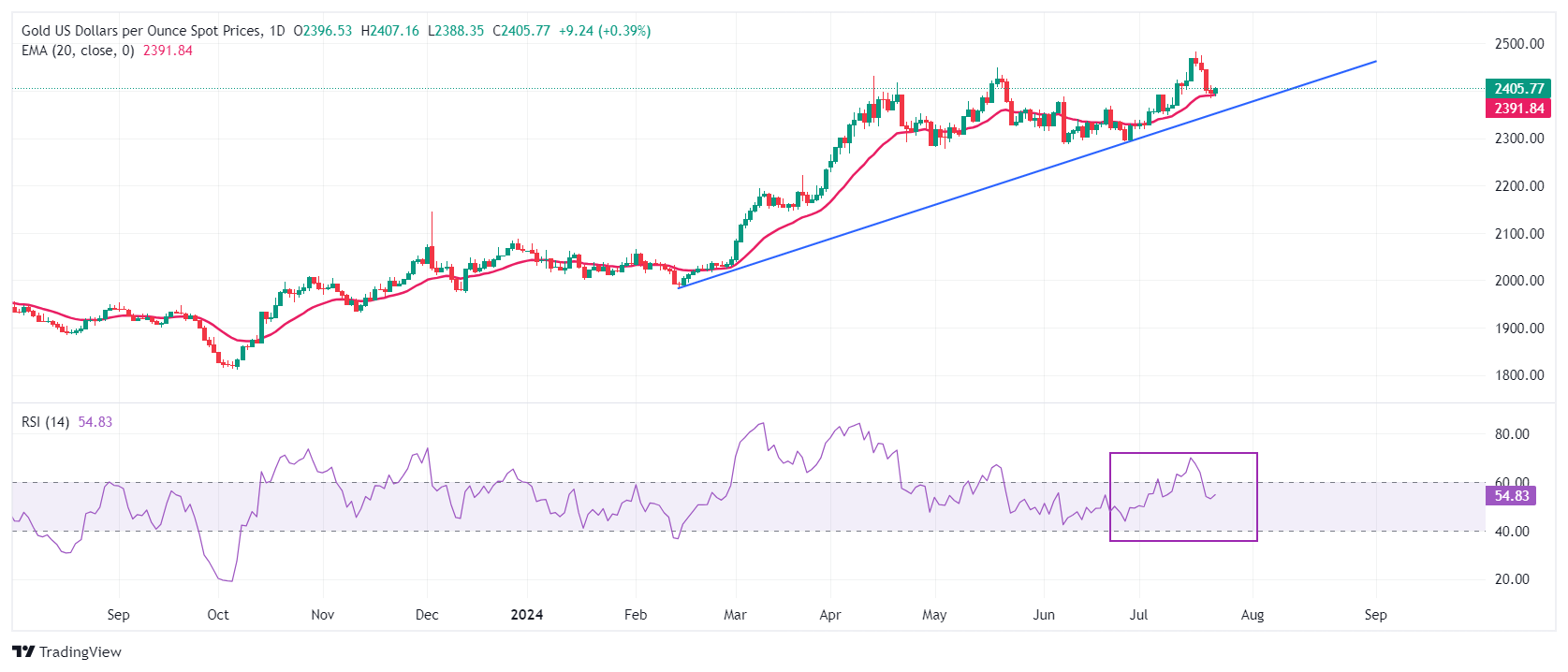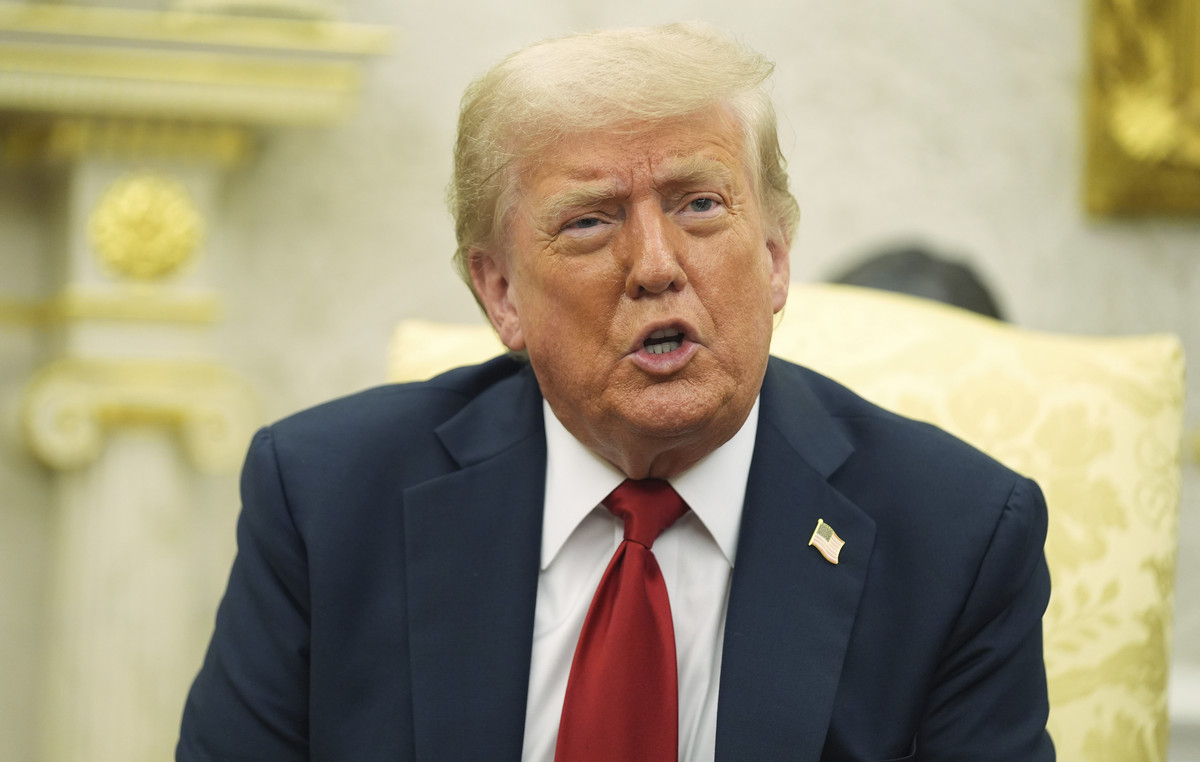- Gold prices trade cautiously ahead of a slew of US economic data
- Strong Fed rate cut hopes will keep the US dollar’s upside limited.
- Gold price in India falls due to reduction in customs duties.
Gold (XAU/USD) price remains on the defensive slightly below the $2,400 round-level resistance in the European session on Tuesday. The precious metal remains under pressure amid strong speculation that Donald Trump could emerge victorious in the United States (US) presidential election in November.
Expectations that Donald Trump will win a second term have risen following an assassination attack on him and US President Joe Biden’s withdrawal from the White House. However, US Vice President Kamala Harris has been chosen as the Democrats’ candidate.
Growing speculation about Trump 2.0 has created upside risks to consumer inflation expectations. In a note on Monday, Australian investment bank Macquarie said: “Trump 2.0 will be a more inflationary policy regime, given that there will be restricted immigration, higher tariffs and the extension of the Tax Cuts and Jobs Act of 2025.” The scenario is favorable for the US Dollar (USD). The US Dollar Index (DXY), which tracks the value of the Dollar against six major currencies, is up near 104.40. An appreciation of the US Dollar makes investing in Gold more expensive for investors.
Market Movers: Gold Price to be Influenced by US Data This Week
- Gold price is struggling to regain ground above the crucial resistance of $2,400. The near-term outlook for the gold price has turned uncertain as investors await a raft of US economic data, which is due for release this week.
- Investors will focus on the US S&P Global Flash PMI for July, second-quarter Gross Domestic Product (GDP) and Durable Goods Orders and Personal Consumption Expenditure (PCE) Price Index data for June, which will provide fresh clues on when the US Federal Reserve (Fed) will start cutting interest rates.
- The manufacturing PMI is estimated to have expanded at a modest pace of 51.7 from the June reading of 51.6. The services PMI, a measure of activities in the service sector, is estimated to have expanded at a slower pace of 54.4 from the previous release of 55.3.
- The main trigger will be the PCE index, the Fed’s preferred measure of inflation, which will indicate whether price pressures remain on track to return to the target 2% rate. Fed officials’ confidence that inflation is back on track to 2% grew after recent inflation readings showed price pressures rising at a slower-than-expected pace in June.
- According to the CME FedWatch tool, 30-day federal funds futures show the central bank will begin cutting its key interest rates from their current levels at the September meeting. The Fed is also expected to cut interest rates again in November or December.
- In the Indian region, the price of gold on the Multi Commodity Exchange (MCX) plummeted below Rs 69,000 after NDA leader Prime Minister Narendra Modi reduced the basic customs duty on precious metals to 6% from 10% in the Fiscal Budget 2024-25. The decision is expected to boost demand for physical gold.
Technical Analysis: Gold Price Remains Below $2,400
Gold price looks vulnerable slightly below $2,400. The precious metal is falling near the 20-day exponential moving average (EMA), which is trading around $2,390, suggesting that the near-term outlook has not weakened technically yet.
The ascending trend line drawn from the February 14 low at $1,984.30 will be an important support for the Gold bulls.
The 14-day Relative Strength Index (RSI) falls within the 40.00-60.00 range, suggesting that the bullish momentum has paused. However, the bullish bias remains intact.
A fresh bullish momentum would emerge if Gold price breaks above the all-time highs above $2,480.
Gold FAQs
Gold has played a pivotal role in human history as it has been widely used as a store of value and a medium of exchange. Today, apart from its luster and use for jewelry, the precious metal is considered a safe haven asset, meaning it is considered a good investment in turbulent times. Gold is also considered a hedge against inflation and currency depreciation as it is not dependent on any particular issuer or government.
Central banks are the largest holders of gold. In order to support their currencies in turbulent times, central banks tend to diversify their reserves and buy gold to improve the perception of the strength of the economy and the currency. High gold reserves can be a source of confidence in a country’s solvency. Central banks added 1,136 tonnes of gold worth about $70 billion to their reserves in 2022, according to data from the World Gold Council. This is the largest annual purchase on record. Central banks in emerging economies such as China, India and Turkey are rapidly increasing their gold reserves.
Gold has an inverse correlation with the US Dollar and US Treasury bonds, which are the main reserve and safe haven assets. When the Dollar depreciates, the price of Gold tends to rise, allowing investors and central banks to diversify their assets in turbulent times. Gold is also inversely correlated with risk assets. A rally in the stock market tends to weaken the price of Gold, while sell-offs in riskier markets tend to favor the precious metal.
Gold prices can move due to a wide range of factors. Geopolitical instability or fears of a deep recession can cause the price of Gold to rise rapidly due to its status as a safe haven asset. As a non-yielding asset, Gold prices tend to rise when interest rates fall, while rising money prices often weigh down the yellow metal. Still, most of the moves depend on how the US Dollar (USD) performs, as the asset is priced in dollars (XAU/USD). A strong Dollar tends to keep Gold prices in check, while a weaker Dollar is likely to push Gold prices higher.
Source: Fx Street
I am Joshua Winder, a senior-level journalist and editor at World Stock Market. I specialize in covering news related to the stock market and economic trends. With more than 8 years of experience in this field, I have become an expert in financial reporting.








